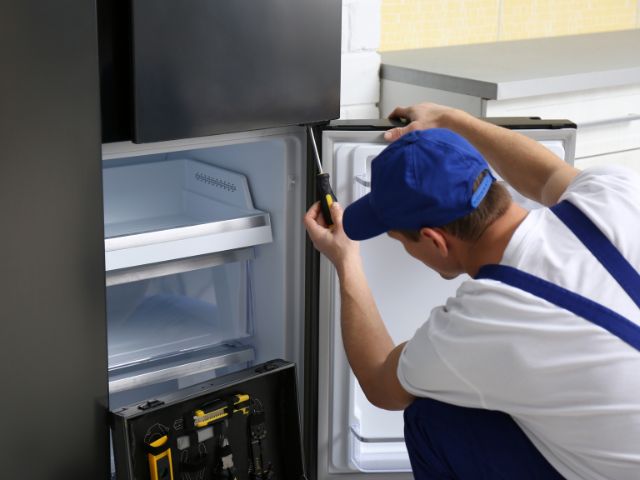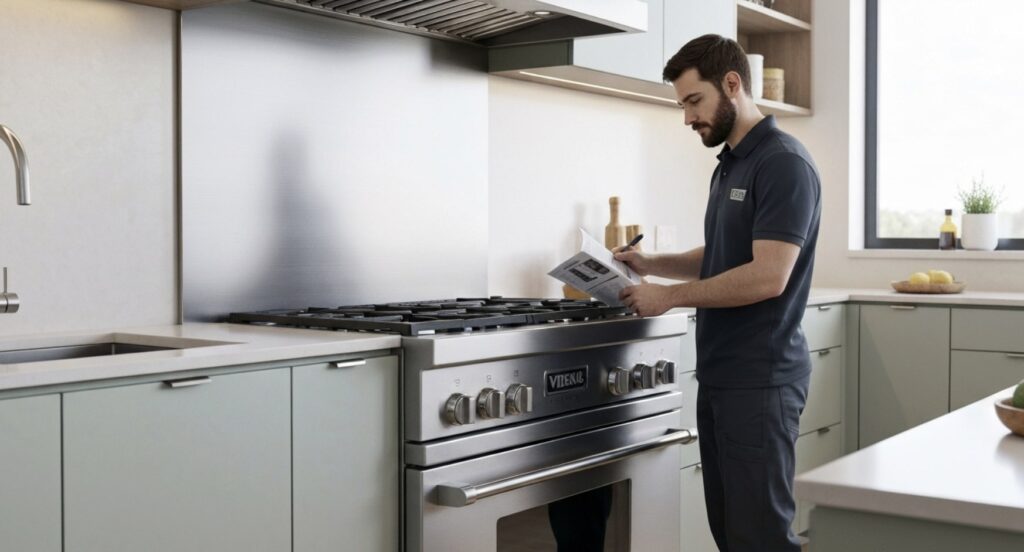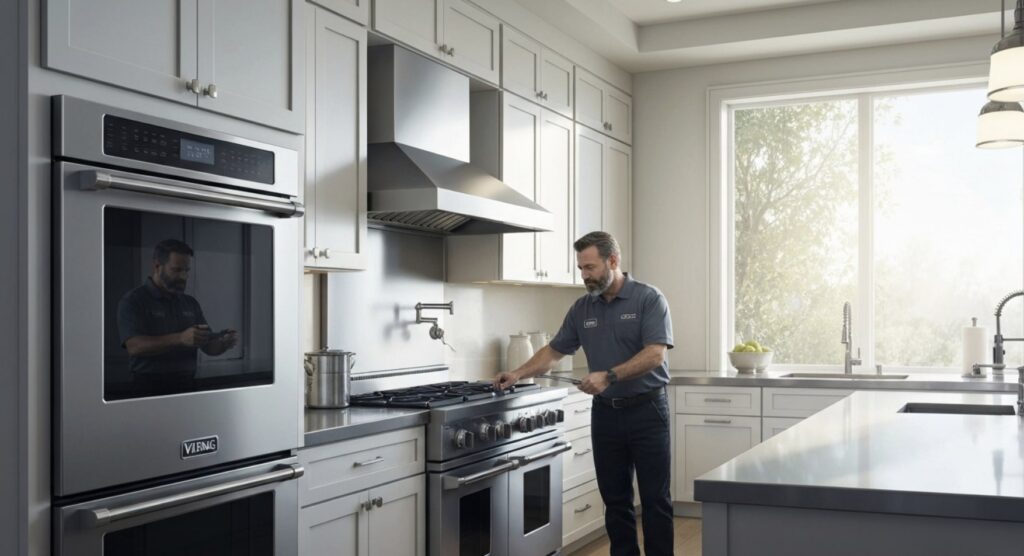A Viking refrigerator is highly valuable for any kitchen. It is known for its stylish look and high performance. However, if your Viking refrigerator is not cooling, it can be very annoying. But don’t worry! This blog will help you understand some common reasons why your Viking freezer may is not freezing. You will learn how to fix this appliance problem in a simple way.
Step-by-Step Troubleshooting for Your Viking Freezer
We created this easy guide to help you fix your Viking freezer. We will go through different problems, from simple things to deeper issues. This way, you can solve the trouble and save time by not needing help from a service. Let’s begin!
Checking for Power and Temperature Settings
Let’s cover the basics. First, check if your Viking freezer is getting power. Make sure the appliance is plugged in properly. Also, see if a circuit breaker has tripped. Sometimes, a power outage in your area can be the problem.
Next, look at the temperature settings. Confirm the thermostat is set to freeze, normally around 0°F (-18°C). If you have a modern Viking freezer with a digital display, this will show you the set temperature. If someone changed it by mistake, just reset it to the right temperature.
- Power Source: Check that your Viking freezer is plugged in and getting power.
- Circuit Breaker: Inspect your home’s electrical panel for any tripped circuit breakers that might affect the freezer.
- Temperature Settings: Ensure the freezer’s thermostat is set to the right freezing temperature, usually 0°F or lower.
Cleaning the Freezer Coils and Condenser Fan
Over time, dust and dirt can build up on the condenser coils. This makes it hard for them to release heat well. As a result, the cooling capacity goes down, and the freezer may struggle to keep things frozen. You can find these coils at the back or under your Viking appliance.
To clean them, first unplug the freezer. Then, use a vacuum cleaner with a brush or a coil cleaning brush to take away the dirt. Also, check the condenser fan. It needs to be clean and clear of anything that may block it.
- Regular Cleaning: Clean your Viking freezer’s condenser coils every three to six months to keep it working well.
- Gentle Handling: Be careful when you clean the coils so you do not bend or harm them.
- Improved Efficiency: Keeping the condenser and fan clean helps air flow better. This improves how well your freezer cools and saves energy.
Inspecting the Door Seal for Leaks
A torn or old door seal can let cold air escape from your Viking freezer. This makes it work harder to stay cold. Check the seal around the freezer door for any rips, gaps, or other issues.
To find leaks, try this test: close the door on a dollar bill. If you can pull the bill out easily, the seal is damaged and should be replaced. Clean the door seal often with warm, soapy water. This helps keep it in good shape and ensures a tight seal.
- Visual Inspection: Check the door seal regularly for any obvious damage like rips, cracks, or mold.
- The Dollar Bill Test: Close the freezer door on a dollar bill. If it comes out easily, the seal is not tight.
- Proper Closing: Ensure the freezer door closes well and is not left open by things inside.
Defrosting the Freezer
Excess ice in your Viking freezer can block efficient cooling. If you see a thick layer of frost on the freezer walls or the evaporator coils, you need to defrost it manually.
First, move the frozen food to a cooler place. Then, unplug the freezer and leave the door open so the ice can melt. You can put bowls of hot water inside to help speed up melting. Once the ice is gone, dry the inside well and plug the freezer back in.
- Timing: Choose a time to defrost when your frozen food is low. This helps reduce thawing time.
- Avoid Sharp Objects: Do not use sharp tools like knives or ice picks to get rid of ice. They can harm the freezer walls.
- Speed Up the Process: Use bowls of hot water (changing them every 30 minutes) inside the freezer to help the ice melt quicker.
Evaluating the Freezer’s Evaporator Fan
The evaporator fan is very important. It helps to move cold air around your Viking freezer. If you hear strange noises or feel that the cooling is not even, the fan may have a problem. Pay attention to any grinding, clicking, or humming sounds, as these can show trouble.
To check the fan, you may have to take off some panels or shelves inside. Look at the fan blades to see if they are blocked and if they turn easily. If you see any damage or if the fan motor is not working, contact a qualified Viking appliance repair technician to get a new one.
- Safety First: Always unplug your Viking freezer before you check the evaporator fan.
- Visual Check: Look at the fan blades for any damage, dirt, or ice.
- Seek Professional Help: Changing the evaporator fan motor usually needs special tools and know-how, so it is better to let professionals do it.
Replacing the Freezer’s Thermostat
The thermostat is like the brain of your Viking freezer. It controls the temperature by managing the compressor and the evaporator fan. If your freezer isn’t cooling well, even with the right temperature settings, it could be due to a bad thermostat. To check it, use a multimeter to see if it has continuity.
If the thermostat isn’t working properly, you will need to replace it. Changing a thermostat may look hard, but it’s actually an easy fix. But, if you are uncomfortable with electrical parts, it’s better to call a Viking appliance repair expert.
- Multimeter Test: Use a multimeter to test the thermostat for continuity while you change the temperature settings. No continuity means there is an issue.
- Compatibility: When you buy a new thermostat, make sure it works with your specific Viking freezer model.
- Calibration: After you install the new thermostat, calibrate it according to the instructions from the manufacturer to get the right temperature control.
Dealing with a Faulty Defrost Timer
For Viking freezers that have automatic defrost systems, a bad defrost timer can mess up the defrost cycle. This can lead to a lot of frost and make cooling less efficient. The defrost timer controls how often the defrost heater runs to melt the frost.
If the timer doesn’t work right, the defrost cycle may not start properly. That can cause ice to build up and stop the freezer from keeping freezing temperatures. To replace a defrost timer, you usually need to find it, unplug the wires, install the new timer, and plug the wires back in.
- Timer Location: Check your Viking freezer’s manual to find the defrost timer. It’s often located behind the control panel or at the base of the appliance.
- Replacement Procedure: Look at the manufacturer’s directions or get help from a technician to replace the defrost timer correctly.
- Preventive Measures: You can manually defrost your freezer regularly, even if it has an automatic defrost system. This can stop too much ice from building up and help the defrost timer work better.
Addressing a Freon Leak
Freon, the refrigerant responsible for cooling in your Viking freezer, can sometimes leak. A Freon leak not only hinders your freezer’s cooling efficiency but also poses environmental risks. If you suspect a Freon leak, it’s crucial to contact a qualified Viking appliance repair technician immediately.
Identifying a Freon leak typically involves checking for signs like a hissing sound coming from the freezer, a chemical odor, or ice buildup on the evaporator coils. Repairing a Freon leak necessitates specialized equipment and expertise, including locating and sealing the leak, recharging the system with the appropriate amount of refrigerant, and ensuring its proper operation.
| Sign of Freon Leak | Description |
| Hissing Sound | A hissing or bubbling noise coming from the freezer. |
| Chemical Odor | A sweet or chloroform-like smell. |
| Ice Buildup on Coils | Excessive ice formation on the evaporator coils. |
| Increased Energy Bills | Your freezer is running constantly but not cooling effectively. |
Conclusion
In conclusion, knowing how to take care of your Viking freezer may not freezing is very important. It helps it work well. You should check the power settings and look at parts like the thermostat and evaporator fan. Taking care of these parts can stop freezing issues. Also, acting quickly can fix common problems before they get worse. If you need more DIY tips, check out our detailed blog on Fixing Viking Freezer Beeping. It has many useful tips and solutions. Stay ahead to make sure your freezer works well to keep your food fresh.
Frequently Asked Questions
How can I manually defrost my Viking freezer if it’s not defrosting automatically?
To defrost your Viking freezer, first unplug the appliance. Remove all food items and leave the door open. Placing towels and bowls of hot water inside will speed up the process. Once the ice melts, dry the interior thoroughly and plug the freezer back in.
What should I do if my Viking freezer is cold but not freezing?
If your Viking freezer is cold but not freezing food properly, check the temperature settings, inspect the door seal for leaks, and ensure the condenser coils are clean and unobstructed.
Are there any warning signs that indicate a Viking freezer is going to stop freezing soon?
Yes, warning signs include unusual noises, excessive frost build-up, food thawing too quickly, the freezer running constantly, and unusually high energy bills.
Helpful Viking Appliance Resources:
Essential Stove Cleaning Hacks for Homeowners
Imperial Beach Viking Refrigerator Repair
Burbank Viking Appliance Service Location
Ultimate Guide: How to Stop an Overflowing Dishwasher
Troubleshooting: Why Your Range Won’t Stop Beeping
El Monte Viking Ice Maker Repair
El Monte Viking Refrigerator Repair
Pearland Viking Cooktop Repair
How to Resolve Viking Appliances Not Turning On Quickly
Anahuac Viking Wine Cooler Repair
Balch Springs Viking Stove Repair
Happy Thanksgiving with Premium Viking Appliance Repair Providers
Channelview Viking Stove Repair
Riverdale Viking Appliance Location
Viking Appliances Feast of Excellence for Thanksgiving
Balch Springs Viking Dishwasher Repair
Cypress Viking Wine Cooler Repair
Santa Clarita Viking Dishwasher Repair
Viking Freezer Repair: Troubleshooting Tips & DIY Fixes
Santa Monica Viking Appliance Location
Campbell Viking Dishwasher Repair
Fix Your Wine Cooler: Reasons It Isn’t Cooling Properly
Bell Gardens Viking Appliance Location
Campbell Viking Wine Cooler Repair
Viking Cooktop Igniter Keeps Clicking: Easy DIY Fixes
Ultimate Guide: How to Choose the Right Size Wine Cooler
Narberth Viking Freezer Repair
Expert Oven Repair Service – Viking Appliance SOS
Tigard Viking Wine Cooler Repair
Long Beach Viking Freezer Repair
Troubleshooting Guide: Dishwasher Isn’t Draining
Expert Tips for Cooktop Ignition Switch Replacement
Expert Viking Refrigerator Service in LA – Fridge Not Cooling
Expert Refrigerator Repair Service – Viking Refrigerator SOS
Long Beach Viking Refrigerator Repair
Bayview Viking Appliance Location
Fixing Refrigerator Temperature Too Warm: Expert Tips
Narberth Viking Microwave Repair – Troubleshooting Solutions






